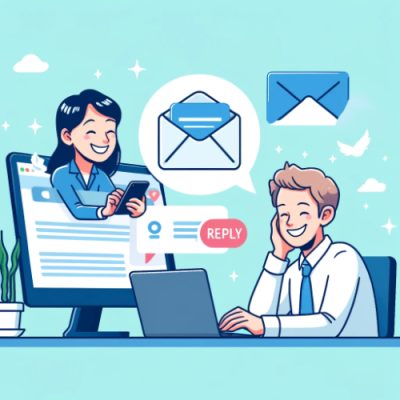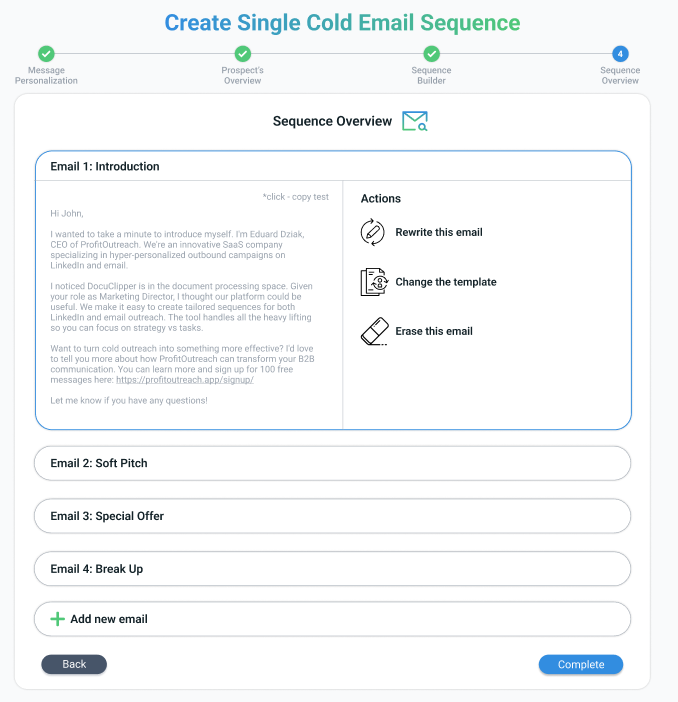As Google, Outlook, and other ESPs are limiting the tracking of cold email open rates, it’s essential to focus on cold email response rates.
In this article, I’ll tell you exactly how you can track your cold email response rate and, more importantly, how you can improve your reply rates above the average!
What is the Average Cold Email Response Rate?
The average cold email response rate typically falls between 1% and 5% according to 20+ sources.
I arrived at this range by analyzing data from multiple sources. Most studies, including Woodpecker, GMass, and Salesmate, report response rates in this lower range.
However, there are exceptions, such as Reddit users and Klenty, which mention higher rates, ranging from 8.5% to even 15%.
Factors like personalization, targeting, and industry play a role in these variations.
Despite some higher outliers, the consensus from a majority of sources is that 1% to 5% is a realistic average for most cold email campaigns.
What is a Good Cold Email Response Rate?
A good cold email response rate generally ranges between 5% and 12%, based on various sources.
If you’re seeing a response rate above 5%, you’re doing better than the average of 1% to 5%, which is typical for most campaigns.
Hitting 15% or higher is considered excellent and means your targeting, personalization, and messaging are resonating well with your audience.
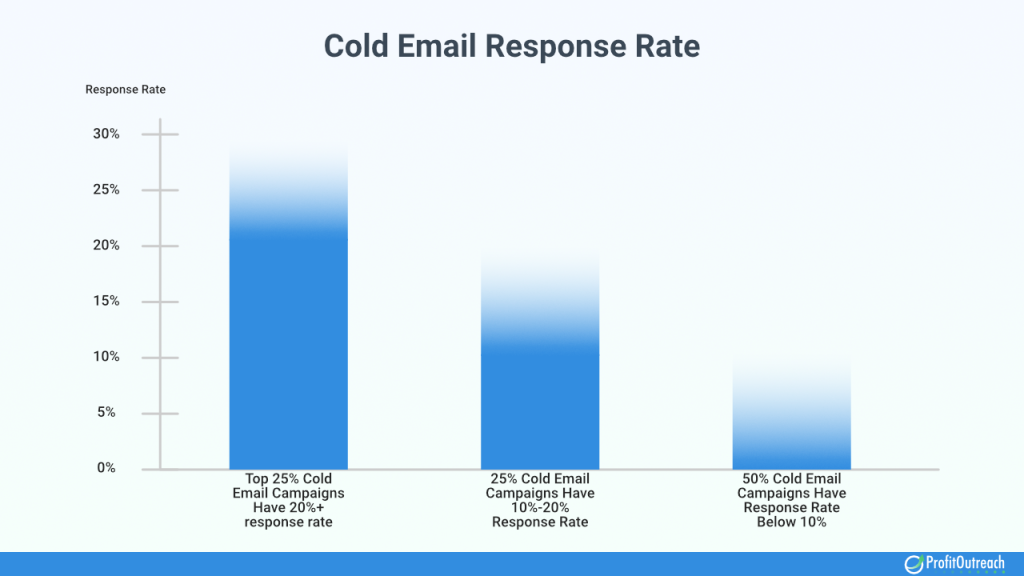
Factors like how personalized your emails are, the quality of your prospect list, and the timing of your emails can all boost your response rate.
If you’re in the 20% range, you’re definitely outperforming the norm!
How to Calculate Cold Email Response Rate?
To calculate your cold email response rate, follow these simple steps:
- Count the number of responses: Track how many recipients replied to your cold email campaign.
- Divide by the total number of emails sent: Take the number of responses and divide it by the total number of cold emails you sent.
- Multiply by 100: Multiply the result by 100 to convert it into a percentage.

For example, if you send 200 emails and receive 20 replies, the formula is (20 ÷ 200) × 100 = 10%. A higher response rate means your email resonated with your audience!
Factors Affecting Cold Email Response Rate
Your cold email response rate is influenced by numerous factors, and getting them all right requires understanding how they work together to craft the perfect cold email.
In this section, I’ll walk you through these key factors and explain how they interact, so you can write cold emails that deliver the best results!
Targeting
Arguably, the most important factor affecting your cold email response rate is targeting.
Proper targeting ensures you’re sending cold emails to the right people who are most likely to benefit from and be interested in your offer.
Every target audience experiences certain pain points and needs, and your goal is to find the right audience that has problems your solution can solve.
For example, imagine trying to sell baby strollers to young, single people. What are the chances they’d be interested?
Yet, in cold emailing, many business owners do something similar out of desperation, targeting as many people as possible. Remember, spray-and-pray methods never work!
Personalization
Another key factor that affects cold email response rates is personalization.
In fact, personalization improves cold email response rate rates by 142%.
Cold email personalization doesn’t just mean using the recipient’s name, company, or job title, though these should be used regardless.
It means doing your research on the target audience and identifying their common pain points, needs, and desires, then connecting these with your solution.
Understanding what keeps your target audience up at night and what motivates them to take action provides valuable insight for crafting your cold emails.
By combining this research with their professional details, you’ll be able to write compelling emails that directly speak to the person receiving them.
Tailored offers will significantly increase both your cold email response rates and, more importantly, your conversion rates!
For example, instead of starting with “Hi, I offer digital marketing services,” you could say, “Hi John, I saw your recent post about scaling your business, and I think my digital marketing strategies could help you get there faster.”
Your Offer
Your offer is what tells your prospects what’s in it for them to reply to you.
If your offer isn’t clear, valuable, or relevant, people won’t feel the need to respond. You have to make it something they can’t resist.
How do you do that?
By addressing their pain points, needs, and motivations. And you cannot do this before nailing down your targeting and personalization.
But to get prospects to reply to you, being personalized is not enough.
You need them to get really excited about what you have to offer.
For example, instead of saying, “We offer digital marketing services,” try offering something specific like, “I can help you gain 10 new clients next month or your money back.”
This gives the recipient a clear, tangible benefit that addresses their needs. When your offer is too generic or vague, people won’t see the value.
But if it’s compelling and solves a problem they have, it motivates them to engage with you, driving up your response rate.
Remember, the potential gain of responding to you has to be far greater than the loss!
Call-To-Action
Another key factor that affects your cold email response rate is your cold email call to action (CTA).
So now you have the right target audience, you personalized your cold emails, and have a great offer!
However, if you don’t tell your prospects what to do next the chances are they will do nothing!
That’s why your cold email CTA is essential for your cold emails!
Research shows that emails with a clear CTA can increase response rates by 20% or more. When your CTA is direct and easy to follow, it removes barriers and encourages the recipient to engage, boosting your cold email’s effectiveness.
Quality of the Prospect List
The quality of your prospect list has a massive impact on your cold email response rate. If your list is filled with irrelevant or outdated contacts, you’re wasting time and lowering your chances of success.
Not only that, but you’re also greatly increasing your chances of ending up in spam and damaging your cold email domain.
That’s why targeting the right audience is crucial. However, it’s just as important to ensure that the email addresses are up-to-date.
Creating a list of prospects for the next 30 days ensures the contact information is relevant and not outdated.
People change jobs frequently, and if you create a list for the next 6-12 months, you may find that 20% of your prospects are no longer with the company by the time your cold emails are sent.
Timing
And the final, super important factor is timing!
On average, a person in a professional setting receives around 120 emails per day.
If you don’t time your cold email when your target audience is checking their inbox, your email might get buried, leaving your prospects never even seeing it, let alone opening, reading, or responding to it.
The best time to send cold emails is during your prospect’s office hours.
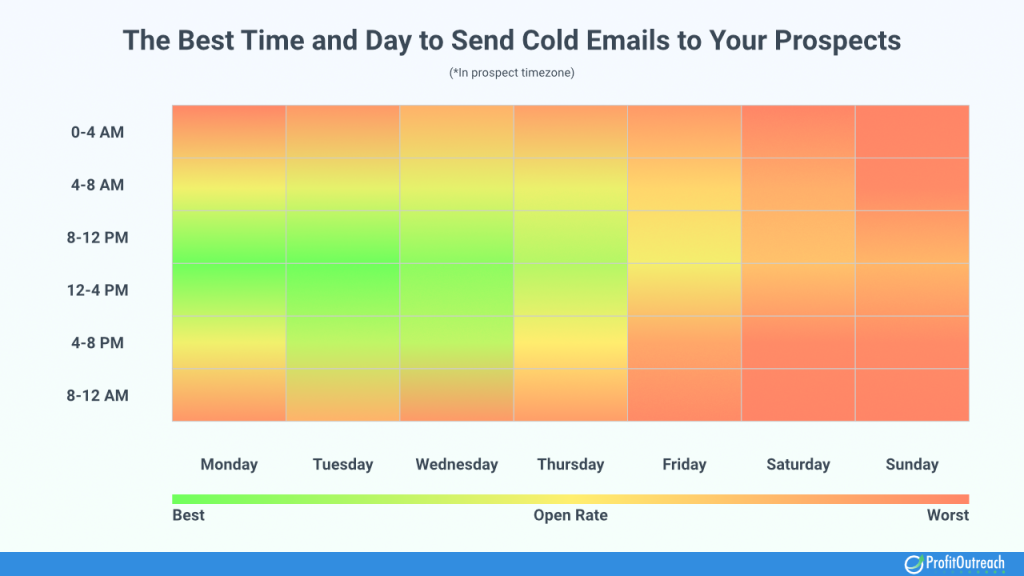
However, the average person checks their email about 15 times a day, both during and outside of office hours.
I’ve tested sending cold emails after office hours, usually between 6-10 PM, and saw no significant negative or positive impact on my response rates, though most responses did come during office hours.
That being said, research shows the best time to send cold emails is between 6-9 AM PST on Monday, with Tuesday as a close second.
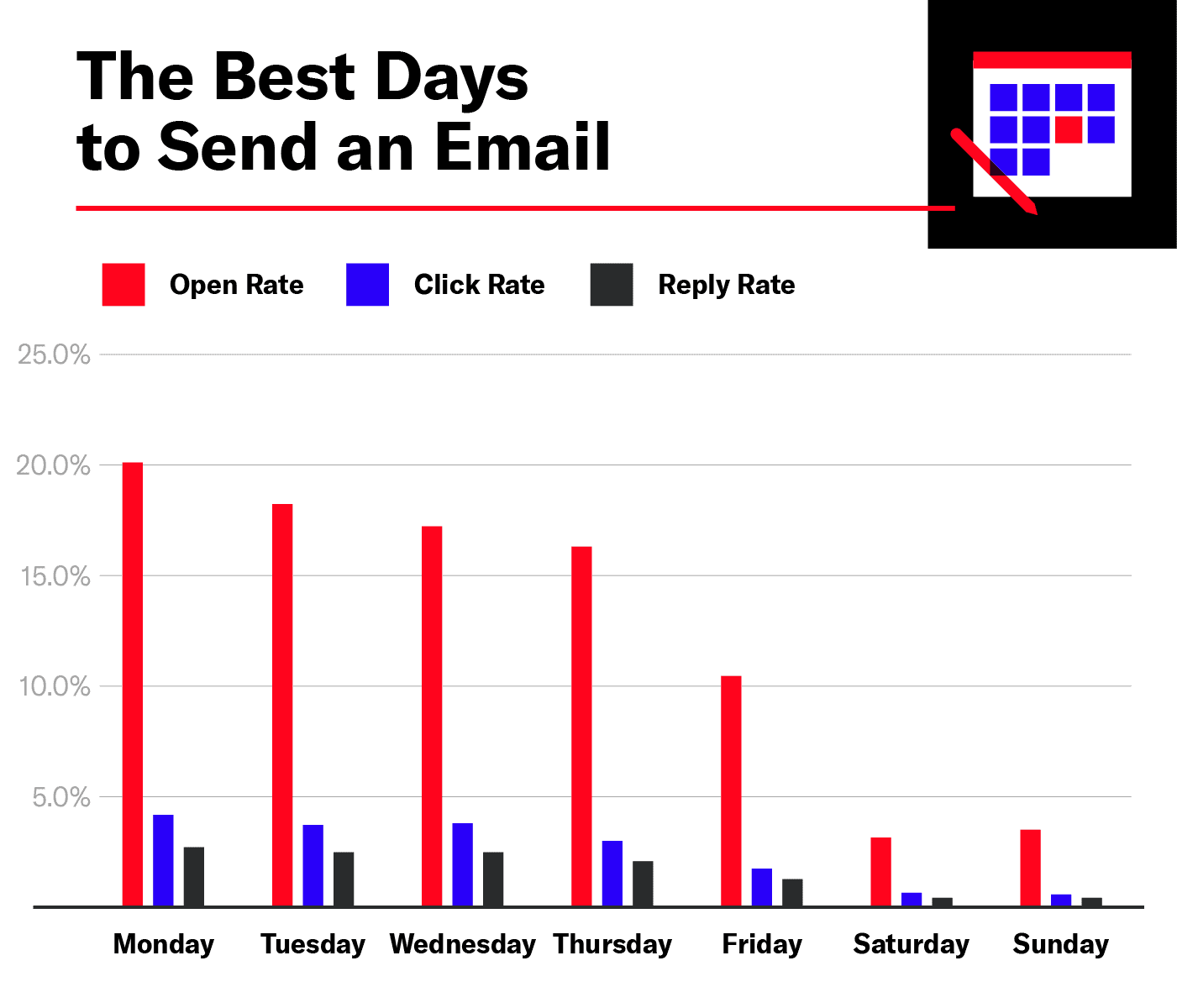
Therefore, I still recommend sending most cold emails during your target audience’s office hours!
How to Improve Cold Email Response Rate
Now, if your cold email response rate does not meet the good or even average benchmark, don’t worry, there are many ways to improve it.
And in this section, I am going to share with you the best practices to improve your cold email response rates:
Personalize Your Cold Emails
Personalizing your cold emails is one of the most effective ways to improve your response rate.
People can easily tell if they’re receiving a generic, copy-paste message, and they’re less likely to respond, even if you’re using variables like the prospect’s name, company name, job title, etc.
A template will always sound like a template. Therefore, it’s crucial to personalize your cold emails.
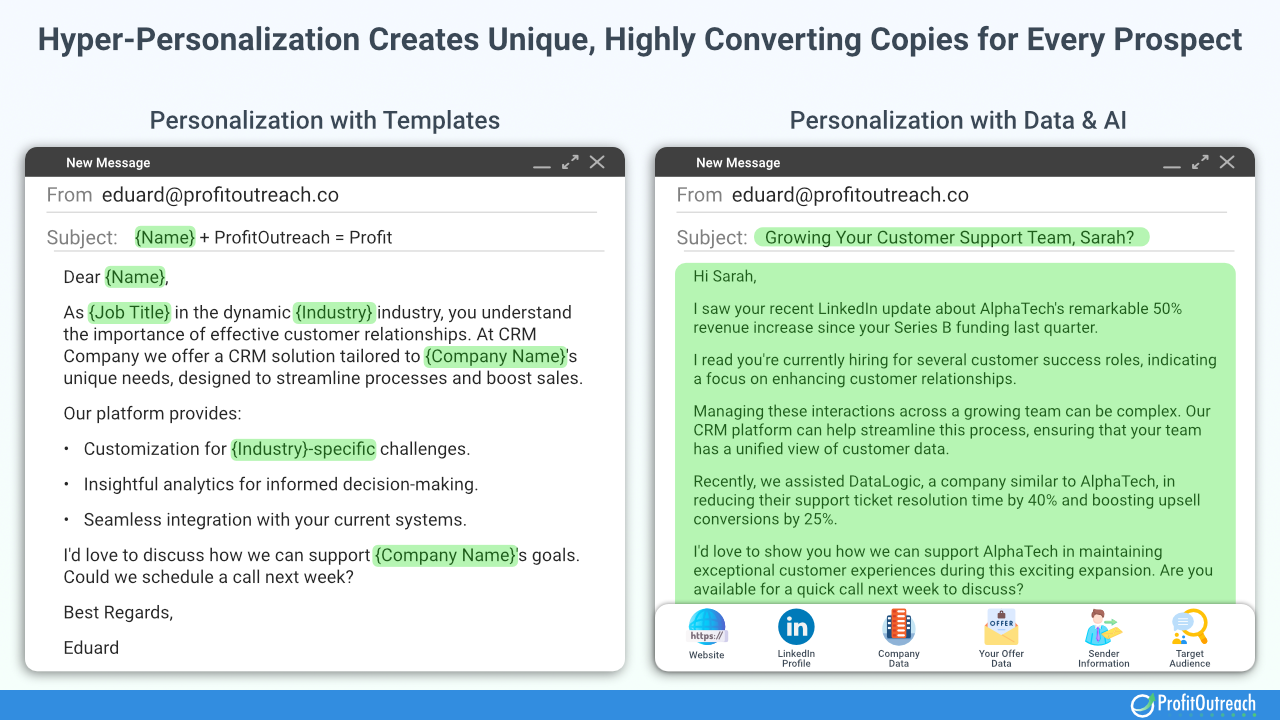
Backlinko reports in its email outreach study that emails with customized content have a 32.7% higher response rate.
With that in mind, your cold email personalization should include basics like the prospect’s name, job title, company name, and other relevant details.
Additionally, you should address their pain points, challenges, and how your solution can solve them.
Personalization is all about understanding your target audience and addressing their needs directly.
Create Cold Email Sequence with Follow-Ups
Studies show that the more follow-ups you have the more replies you get.
In fact, cold email campaigns with follow-ups are 2-3 times more likely to get a reply.
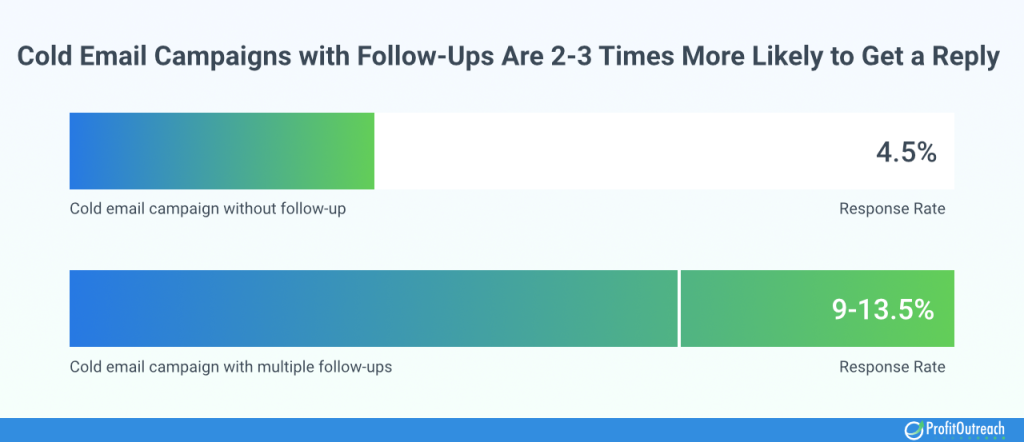
While individual reply rates below 2% might seem unimpressive, the cumulative effect of each follow-up can boost the combined reply rate above 20%.
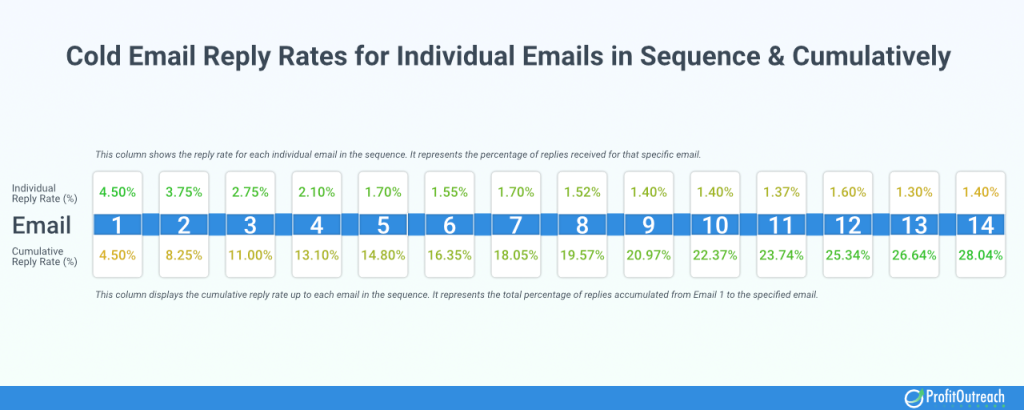
For example, if you send one email, you might see an average reply rate of 4.5%.
However, if you send up to 10 follow-ups, your total reply rate can reach as high as 22.37%.
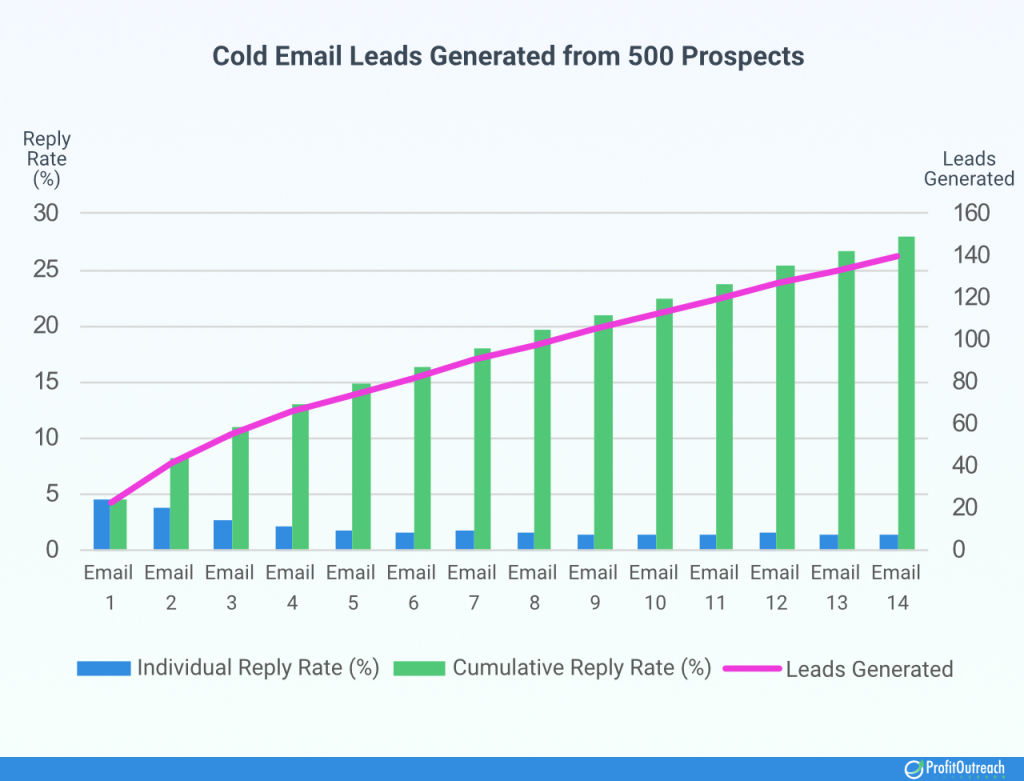
Here’s the revised version with improved grammar:
That said, writing cold email follow-ups comes down to understanding your target audience, the buyer’s journey, and gaining experience.
However, it’s essential to ensure that every email in your cold email sequence provides unique information.
For example, your cold email sequence could look like this:
- Email 1: Introduction
- Email 2: Value Proposition
- Email 3: Testimonials
- Email 4: Benefits
- Email 5: Exclusive Offer
- Email 6: Final Follow-Up
This is just one example, but you can visit my library of cold email templates and use them to build your own sequence.
Remember, it’s important to put yourself in your prospects’ shoes and consider what information would motivate them to reply.
Always A/B Test Your Cold Emails
A/B testing is like water for plants, if you don’t do it your cold email campaigns will eventually die!
It’s a must if you want to consistently improve your response rate.
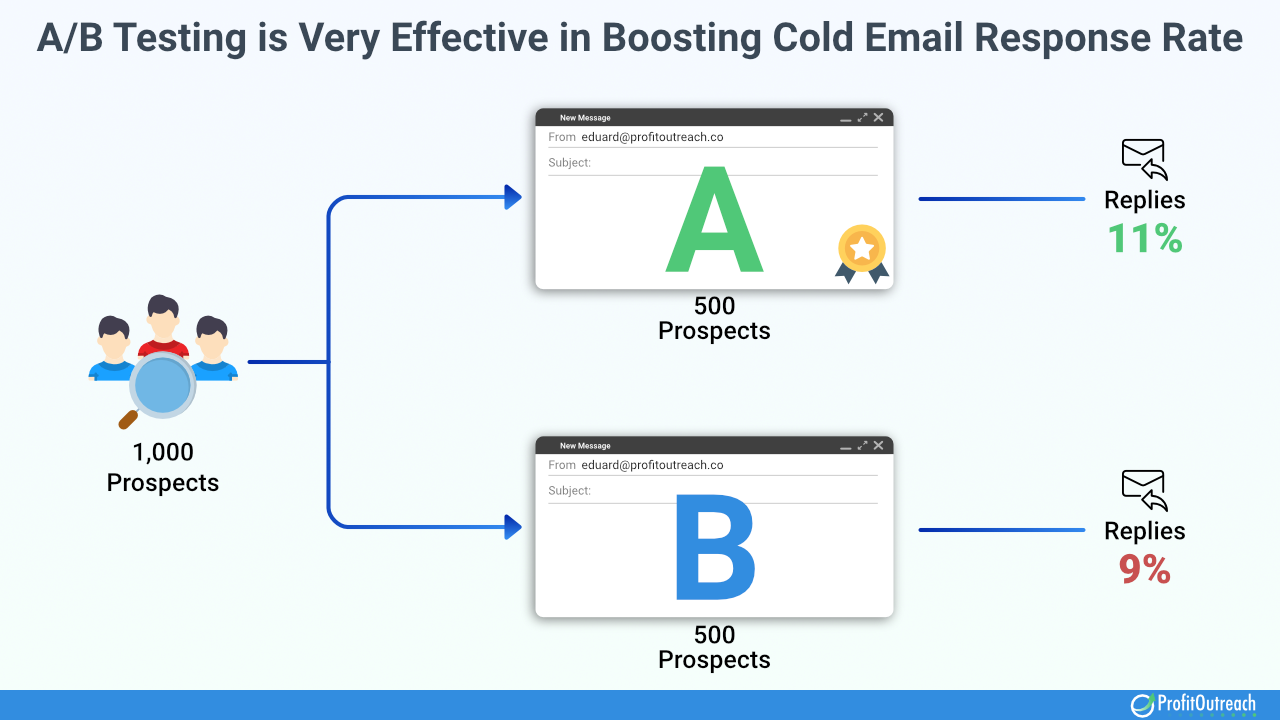
In fact, A/B testing can improve cold email engagement rates by up to 49%.
The deal is you never know what works the best for your target audience.
Despite all the best practices, tips, and tricks available online, you can never know until you test them!
That’s why you should always run cold email A/B testing.
You can test your subject lines, your copies, types of cold email templates, audiences, greetings, CTAs, timing, and anything you can think of that influences your cold email results.
For example, you can test different subject lines—one might be “Increase your sales in 30 days” and another “Let’s chat about boosting your sales.”

With that, here are some best practices for cold email a/b testing.
- Test One Variable at a Time: Focus on one element at a time (e.g., subject line or email body) to ensure accurate results.
- Set Clear Goals: Define what success looks like, whether it’s higher open rates, click-through rates, or responses.
- Use Personalization: Personalizing one variant more heavily than the other can help understand how much customization impacts response rates.
- Analyze and Iterate: Once a winning variation is found, continuously optimize by testing new elements to drive further improvements.
Clean Up Your Prospect List
When you scrape or download your initial prospect list, you’ll find that many irrelevant prospects need to be removed.
Additionally, some of the email addresses will be outdated, and those should be removed as well.
You also don’t want to reach out to 50 prospects from the same company; instead, select only the top 5 most relevant prospects and remove the rest.
All of this should be done before sending any cold emails because it ensures you’re targeting the right people, reduces the chances of being marked as spam, and increases engagement.
In fact, research shows that 83% of global email traffic never reaches the inbox due to issues like invalid emails or spam filters.
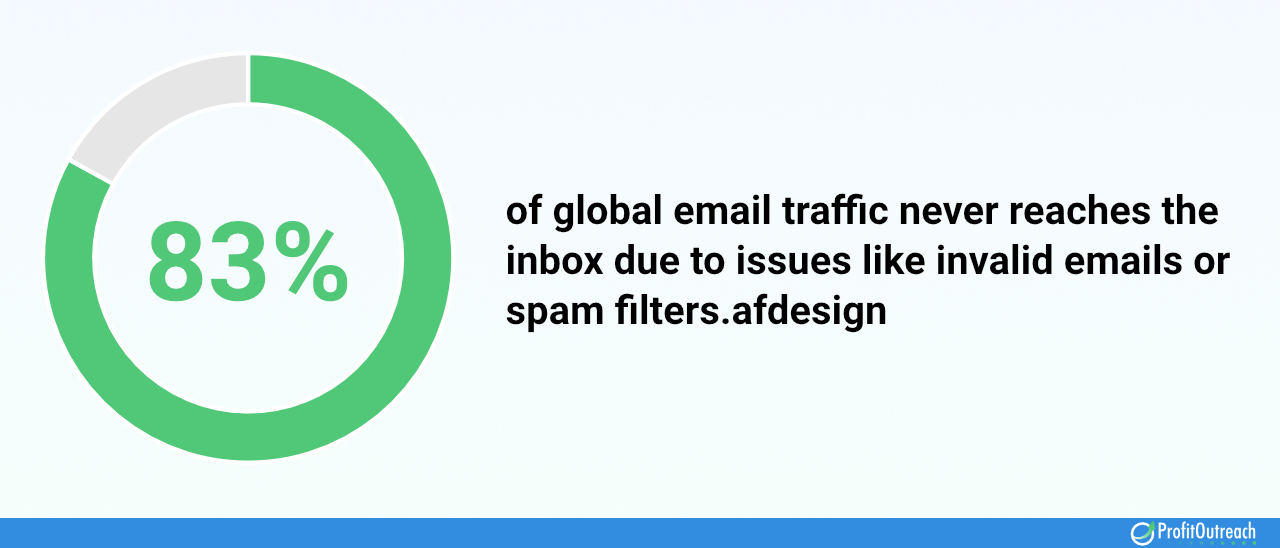
Cleaning your list improves deliverability by removing incorrect or outdated contacts.
HubSpot found that cleaned prospect lists can increase open rates by 28% and response rates by 18%.
Here’s what I always do to clean up my list:
- Keep up to 5 prospects per company, focusing on the most relevant.
- Remove irrelevant prospects. For example, if I’m targeting sales professionals, marketing or HR prospects may be on the list.
- Remove invalid and inactive emails. Use tools like ZeroBounce or NeverBounce to detect these.
- Ensure that the prospects match the target. Sometimes I’m targeting consulting firms, but manufacturing or e-commerce companies end up on the list.
Nail Down Your Targeting
Arguably, the most important and also the most difficult part of cold emailing is finding the right target audience.
Especially from a founder’s perspective, you can think of countless ways your product could be useful.
However, the key to cold emailing is identifying the most obvious benefit of your solution and matching it with the most obvious target audience.
For example, if you’re selling horse saddles, you’ll target people or companies that need saddles, right?
Yet in B2B, especially in SaaS, business owners often think of ways their “saddle” could be used for cows, in cars, or by coaches, and they end up targeting all these potential prospects—only to be surprised by low or even poor cold email response rates.
So, find the most obvious target audience for your solution and focus on them first!
Segment Your Prospects
Segmenting your prospects is crucial for improving your cold email response rate because it allows you to personalize your cold emails to specific groups.
Instead of sending the same email to everyone, break your prospects into segments based on factors like industry, company size, job title, or previous interactions.
In most cases, you’ll be able to target different roles within a company, which means you’ll need to segment them to create truly personalized and effective cold email campaigns.
For example, let’s say you’re selling CRM software to SMBs and you have four potential ICPs (ideal customer profiles) per company:
- Sales
- Marketing
- Customer Service
- CEOs/Leadership
Each of these has different needs, challenges, and reasons for needing CRM software.
That’s why you need to segment your target audience further, so you can accurately address the pain points, needs, and motivations of each specific group!
Optimize for the Best Cold Email Deliverability
If your cold emails don’t let in your inbox, then whatever you do, your cold email response rates will always be bad.
So, optimizing for cold email deliverability is crucial to ensure your emails actually land in your prospects’ inboxes, not their spam folders.
- Use Workspace or Microsoft 365 as ESPs: These trusted platforms have strong email deliverability and spam filter protection, helping your cold emails reach the inbox.
- Have a separate cold email domain: Using a dedicated domain for cold emails protects your main domain’s reputation in case of issues like high bounce rates or spam complaints.
- Have around 3-5 email accounts per domain: This prevents any single account from being overused and flagged, spreading out your sending activity for better deliverability.
- Send a maximum of 200 cold emails per day per domain and 30-50 emails per account: Limiting the volume keeps you under the radar of spam filters.
- Clean your email list regularly: Remove inactive or invalid addresses to avoid high bounce rates, which hurt your sender’s reputation and deliverability.
There are a lot more best practices for cold email deliverability and you can read my article.
Optimize for the Best Cold Email Open Rates
Unfortunately, Google and other ESPs are limiting our ability to track cold email open rates.
However, just because we cannot track them, it doesn’t mean we should ignore them.
There are many strategies you can use to maximize your open rates.
Here are some of my favorites:
- Personalize Your Subject Line: A personalized subject line grabs attention and increases the likelihood of your email being opened.
- Send Cold Emails to Only Business Personal Email Accounts: Avoid generic info@ emails and focus on reaching individuals within the company.
- Use a Professional Email Address: Sending from a business email domain builds trust and credibility.
- Optimize Your Sending Time: Emails sent between 9 AM and 11 AM, mid-week, typically have higher open rates.
- Redirect Your Cold Email Domains to Your Main Domain: This helps build trust with prospects by making it easier for them to research your company.
- Have an Optimal Number of Follow-Ups: 3-4 follow-ups is the sweet spot to increase open and response rates without overwhelming prospects.
Follow the One Copywriting Method
The “One Copywriting Method” is one of my favorite ways to improve my copies, regardless of whether it’s for cold email, website, email marketing, ads, or any other marketing channel.
- One Target Audience
- One Segment
- One Information
- One Call-to-Action
By targeting one audience, addressing one segment, delivering one piece of information, and having one call-to-action (CTA), you simplify the email and make it easier for you to focus and deliver your message.
For example, if you’re reaching out to small business owners in the tech industry, don’t overwhelm them with multiple offers or information.
Instead, focus on the single biggest benefit—like improving their lead generation—and include a simple CTA, such as “Schedule a quick 10-minute call.”
This method works because people have limited attention spans, and a focused message resonates better.
Studies show that emails with one clear CTA increase response rates by 42%.
When you focus on one thing at a time, it makes personalization easier, the email more relevant, and drives more direct results by avoiding confusion or overload.
What is the Cold Email Response Rate?
Cold email response rate is the percentage of recipients who reply to your cold email campaign.
For example, if you send 100 emails and get 10 replies, your response rate is 10%. A higher response rate indicates that your message resonated with your audience.
Factors such as personalization, targeting, timing, and the quality of your prospect list all impact this rate.
Monitoring your cold email response rate helps you gauge the effectiveness of your outreach and improve future campaigns.
Why is a Cold Email Response Rate Important?
The cold email response rate is important because it measures the effectiveness of your outreach efforts and it gives you crucial information on whether your cold email campaigns are doing well, average, or below average.
A high response rate indicates that your emails are engaging, relevant, and resonate with the recipients.
This metric helps you identify which messaging strategies work, refine your targeting, and optimize future campaigns.
Additionally, a higher response rate can lead to more conversations, potential partnerships, or sales opportunities, making it crucial for improving overall business outcomes.
How ProfitOutreach Improves Your Cold Email Response Rate?
Ready to take your cold email outreach to the next level?
With ProfitOutreach, you can create hyper-personalized email sequences that speak directly to each prospect.
We analyze data from your prospects’ websites and companies to craft unique emails tailored to their needs. Simply provide essential details about your business, customers, and offers, and let ProfitOutreach handle the rest.
Upload 100s or even 1,000s of prospects, and we’ll deliver personalized cold email sequences for every one of them.
Try ProfitOutreach now and see your cold email response rates soar!
FAQs about Cold Email Response Rate
In this section learn more about cold email response rates:
How can I improve my cold email response rate quickly?
To improve your cold email response rate quickly, focus on personalization, craft compelling subject lines, and target the right audience. Segment your prospects and send follow-up emails. Keep your message clear and concise with a strong call to action for better engagement.
How many follow-ups should I send?
Sending 3 to 4 follow-up emails is optimal for increasing cold email response rates without overwhelming prospects. Space them out over a few days, keeping the message polite and focused on offering value. Response rates improve significantly with consistent follow-ups.
What tools help with cold email personalization?
Popular tools for cold email personalization include ProfitOutreach, Lemlist, and Woodpecker. These tools allow you to customize email content based on prospect details, track engagement, and automate follow-ups, helping to boost response rates through hyper-targeted outreach.
What’s a good cold email reply rate?
A good cold email reply rate typically falls between 5% and 12%. Achieving rates higher than 5% means your messaging, targeting, and personalization are effective. However, anything above 8% is considered excellent and indicates strong engagement from your audience.
What is the 30 30 50 rule for cold emails?
The 30 30 50 rule for cold emails suggests 30% of your success comes from targeting, 30% from your offer, and 50% from the quality of your list. This rule emphasizes the importance of hitting the right audience with a valuable offer through a well-curated list.
What is the success rate of B2B cold emails?
The success rate of B2B cold emails typically ranges from 15% to 28%, depending on factors like personalization, targeting, and industry. Success is often measured by open, reply, or conversion rates, with highly personalized and targeted emails seeing higher success.
What is the average response rate for B2B emails?
The average response rate for B2B cold emails is around 1% to 5%. However, well-targeted and personalized B2B emails can achieve response rates of 8.5% or higher, depending on the industry and email strategy used.
Related Articles:
- Best Cold Email Software Companies
- How to Craft Best Cold Email Subject Lines with Examples
- Cold Email Copywriting Ultimate Guide: Tips & Best Practices
Related Cold Email Sequences:
- How to Create Effective Consulting Services Cold Email Sequence for More Consulting Leads
- Create Effective Product Cold Email Sequence: Examples, Best Practices, and Tips
- How to Create an Investor Pitch Cold Email Sequence for Successful Fundraising
